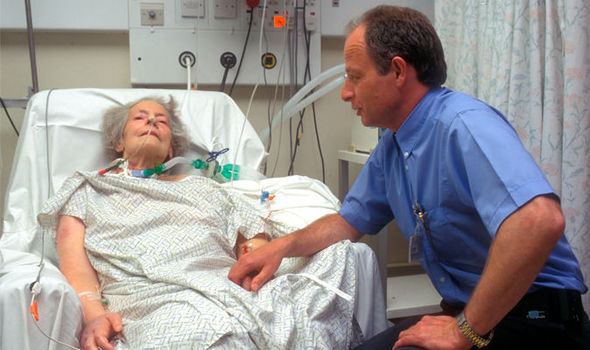When a person is told they need palliative care, it can be an emotional and confronting thing for them and their loved ones. It is quite natural to feel afraid when hearing the words ‘palliative care’ for the first time, but with the right information and support the process can be made easier.
Palliative care essentially means that a person is at the end of their life, and a big focus is on keeping them or comfortable so that they are able to live out their or final time on this earth – with a focus on the quality of life rather than counting the days.
The World Health Organisation defines palliative care as “the active total care of patients whose disease is not responsive to curative treatment. Control of pain, other symptoms, and of psychological, social, and spiritual problems, is paramount. The goal of palliative care is the achievement of the best quality of life for patients and their families.”
Palliative care can seem like a scary process, but essentially it’s a support system to help a patient and their loved ones cope.
The Principles Of Palliative Care
Palliative care is not simply a process that a patient undergoes in the hospital by themselves. It’s a philosophy that is integrated into their overall care and the care their family receives.
Palliative care;
- Affirms life and regards dying as a normal process
- Neither hastens nor postpones death
- Provides relief from pain and other distressing symptoms
- Integrates the psychological and spiritual aspects of care
- Offers a support system to help patients live as actively as possible until death
- Offers a support system to help patients’ families cope during the patient’s illness and in their own bereavement
Pain Management
Physical pain is an unfortunate part of many health conditions at the end of life stage. Although it is a common symptom, not everyone receiving palliative care support will experience pain.
Pain relief should therefore be something that includes the physical, psychological, social, and spiritual aspects of suffering.
As pain is layered and multidimensional, there is no one way of treating it. Physical pain cannot be treated separately from the psychology and anxieties of pain. And vice versa, the mental suffering cannot be addressed independently from the physical experience.
The first principle of managing pain is an adequate and full assessment of where the underlying pain is coming from. Keep in mind that patients may have more than one area of pain and different pains have different causes.
The World Health Organisation have developed three-step “ladder” for pain relief in adults, which can essentially be used in palliative care.
They recommend that pain medication should be given “by the clock” – which is approximately every 3-6 hours, rather than “on demand”.
If pain occurs, there should be prompt oral administration of drugs in the following order:
- non-opioids (aspirin and paracetamol);
- then, as necessary, mild opioids (codeine);
- then strong opioids such as morphine, until the patient is free of pain.
To calm fears and anxiety, additional drugs – “adjuvants” – should be used.
A comprehensive knowledge of the underlying pathophysiology of pain is essential for effective management. The three-step approach of administering the right drug in the right dose at the right time is supposed to be inexpensive and 80-90% effective.
There must always be a considerations given to treating the underlying cause of the pain – this could be by surgery, radiotherapy, chemotherapy, or other appropriate measures.
Where Can People Access Palliative Care?
Palliative care is provided where the person and their family want, where possible. It is not exclusively locked into a clinical or hospital setting.
This may include:
- At home
- In hospital
- In a hospice
- In a residential aged care facility
Many people indicate a preference to die at home and making this possible often depends on several factors, such as the nature of the illness, the amount of care the person needs, how much support is available from the person’s family, and whether the person has someone at home who can provide physical care and support for them.
Attitudes and principles required for successful palliative care
A caring attitude
- involves sensitivity, empathy, and compassion, and demonstrates concern for the individual
- there are a concern for all aspects of a patient’s suffering, not just the medical, nursing, or social work problems
- there is a non-judgmental approach in which personality, intellect, ethnic origin, religious belief, or any other individual factors do not prejudice the delivery of optimal care
Consideration of individuality
- the practice of categorizing patients by their underlying disease, based on the similarity of the medical problems encountered, fails to recognize the psychosocial features and problems that make every patient a unique individual
- these unique characteristics can greatly influence suffering and need to be taken into account when planning palliative care for individual patients
Cultural considerations
- ethnic, racial, religious, and other cultural factors may have a profound effect on a patient’s suffering
- cultural differences are to be respected and treatment planned in a culturally sensitive manner
Consent
- the consent of a patient, or those to whom the responsibility is delegated, is necessary before any treatment is given or withdrawn
- the majority of patients want shared decision making although physicians tend to underestimate this
- having assessed what treatment is appropriate or inappropriate, this is discussed with the patient
- in most instances, adequately informed patients will accept the recommendations made if they have been explained in non-medical jargon.
Choice of the site of care
- the patient and family need to be included in any discussion about the site of care
- patients with a terminal illness should be managed at home whenever possible though in the developed world few do so, most dying in hospitals
Communication
- good communication between all the healthcare professionals involved in a patient’s care is essential and is fundamental to many aspects of palliative care. There is strong evidence that such communications are less than optimal.
- good communication with patients and families is also essential
Clinical context: Appropriate treatment
- all palliative treatment should be appropriate to the stage of the patient’s disease and the prognosis
- over-enthusiastic investigations, therapy that is inappropriate, and patient neglect are equally deplorable
- Palliative care has been accused of the medicalisation of death, and care must be taken to balance technical interventions with a humanistic orientation to dying patients. This is where a team approach is essential, each member of the team being able to see different aspects of the patient’s suffering, personality and needs.
- the prescription of appropriate treatment is particularly important in palliative care because of the unnecessary additional suffering that may be caused by inappropriately active therapy or by lack of treatment
- when palliative care includes active therapy for the underlying disease, limits should be observed, appropriate to the patient’s condition and prognosis and expressed wishes which may be different from those of the clinicians
- the treatment known to be futile, given because ‘you have to do something, is unethical
- where only symptomatic and supportive palliative measures are employed, all efforts are directed at the relief of suffering and the quality of life, and not necessarily at the prolongation of life
Comprehensive inter-professional care
- the provision of total or comprehensive care for all aspects of a patient’s suffering requires an interdisciplinary team
Care excellence
- palliative care should deliver the best possible medical, nursing, and allied health care that is available and appropriate
Consistent medical care
- consistent medical management requires that an overall plan of care be established, and regularly reviewed, for each patient
- this will reduce the likelihood of sudden or unexpected alterations, which can be distressing for the patient and family. It may lessen the chance of crises or medical emergencies which can frighten the patient and relatives.
Coordinated care
- involves the effective organization of the work of the members of the inter professional team, to provide maximal support and care to the patient and family
- care planning meetings, to which all members of the team can contribute, and at which the views of the patient and the family are presented, are essential to developing a plan of care for each individual patient
Continuity of care
- the provision of continuous symptomatic and supportive care from the time the patient is first referred until death is basic to the aims of palliative care
- problems most frequently arise when patients are moved from one place of care to another and ensuring continuity of all aspects of care is most important (A useful means of delivering this is the Liverpool Care Plan. See the Recommended Reading List)
Crisis prevention (see Consistent Medical Care)
- good palliative care involves careful planning to prevent the physical and emotional crises that occur with progressive disease
- many of the clinical problems can be anticipated and some can be prevented by appropriate management
- patients and their families should be forewarned of likely problems, and contingency plans made to minimize physical and emotional distress
Caregiver support
- the relatives of patients with advanced disease are subject to considerable emotional and physical distress, especially if the patient is being managed at home
- particular attention must be paid to their needs as the success or failure of palliative care may depend on the caregivers’ ability to cope
- Palliative care, whether at home or in a hospital, often succeeds or fails to depend on the care and support provided for the caring relatives
Continued reassessment
- is a necessity for all patients with advanced diseases for whom increasing and new clinical problems are to be expected
- this applies as much to psychosocial issues as it does to pain and other physical symptoms
Communication with Patients
Important and potentially difficult discussions are frequently necessary with palliative care patients who have active, progressive, far-advanced diseases, regarding
- breaking bad news
- further treatment directed at the underlying disease
- communicating prognoses
- admission to a palliative care program
- artificial nutrition
- artificial hydration
- medications such as antibiotics
- do-not-resuscitate orders
Decisions must be individualised for each patient and should be made in discussion with the patient and family. The following guide is to help you plan for and hold such discussions.
Before the Discussion
Ask yourself these questions:
Would you be surprised if this patient died of their disease within 6 months?
Bear in mind that even doctors with long experience tend to over-estimate prognosis.
This may provide a better guide for decision-making, as attempting to prognosticate may be difficult and inaccurate. Alternatively, assess how much the patient’s condition has deteriorated in the last month or six weeks, using observations by the team and objective measures such as x-rays and biochemistry. Observations by close relatives often help.
What specific therapies are available to treat the underlying disease?
- What are the percentage chances of significant clinical improvement? __%
- Does that take into account the patient’s age and any other diseases/co-morbidities?
- How long would the improvement last? Days, weeks, or months?
- What are the percentage chances of serious adverse effects? __%
- Does that take into account the patient’s age and any other diseases/co-morbidities?
- On balance, do the potential benefits outweigh the potential burdens?
About the Patient and Family
- What is their understanding of the state of the disease and the prognosis?
- Do they understand the goal of any treatments to be discussed (i.e. palliative, not curative)?
- Do they understand the potential benefits and burdens of the treatment options?
- What are their expectations? What are they hoping for?
- What do you think their preferences are?
The Discussion
Appropriate setting
- Discussions should be held in person and not by telephone, except when face-to-face meetings are not possible for geographic reasons
- Privacy, prevent interruptions (leave your pager/mobile with someone else)
- Sitting down where the patient / relative can see your face (not standing over the patient’s bed)
- Allow enough time
- The patient has at least one family member or friend for support
Introduce the discussion
- e.g. We need to talk about your current problems and our goals for your care
Find out what they understand
- e.g. “Tell me in your own words what you understand about your illness at the moment. Don’t worry if you cannot remember medical terms.”
Find out what they expect
- e.g. “Tell me what you see happening with this illness in the future”
- e.g. “Tell me what things are important for you, perhaps things you’ve not mentioned before “
- e.g. “Tell me what you don’t like about what we’ve done or said – we won’t be upset or angry, I promise you.”
Provide medical information, if necessary
- in a caring and sympathetic way, not abruptly or bluntly
- in a way they can understand
- keep asking them to explain back to you what you have just tried to explain to them
- clearly (avoid euphemisms and medical jargon)
- what treatments can be offered
- the possible benefits and adverse effects of any treatments
- as much or as little information as they want (if unsure, ask them how much they want. “ Am I telling you too much at one time to take in? Would you like me to go over any of that again but explain it differently?)
- use trained interpreters. (Strictly what you need is a translator, not someone who interprets what is being said and as a consequence gets it wrong)
Discuss realistic possibilities in the context of their view of the present and future
Discussing further active treatment for the underlying disease
- truthful discussion of what therapy is or is not available
- the benefits and burdens of any therapies
- Never say ‘there is nothing more that can be done
-
- patients interpret this to mean no treatment for anything
- it is never true
- patients and families will feel abandoned
- patients may be told there is no further therapy for the underlying disease, but the provision of continuing care and symptom control should be stressed
- if further active therapy for the underlying disease is not appropriate, emphasise the positive aspects of symptomatic and supportive palliative care. Stress to the patient that he or she matters and is not a burden.
Discussing prognoses
- Explain the uncertainty in estimating an individual patient’s prognosis
- Avoid precise prognostication
- Give a realistic time range
- Provide realistic hope—helping them to achieve what is important to them
- Recommend that family relationships and worldly affairs be attended to
- Be prepared to answer questions about the process of dying. Remember that most people are more afraid of dying that of death itself.
- Provide ongoing support and counselling
- Reassure about continuity of care
Discussing admission to palliative care units/services
- discuss palliative care in the context of how it can help them achieve their goals
- e.g. You have told me you would like to………….. Palliative care may be able to help you achieve what you want
- emphasize the positive aspects of palliative care
- e.g. living as well as possible, for as long as possible; not ‘giving up
Discussing appropriate medical care
- Issues related to the appropriateness of artificial hydration and nutrition, antibiotics and other medications are dealt with in the section on Ethical Issues
- Explain the possible benefits and burdens (or futility) of any intervention. Patients appreciate such honesty
- If the agreement is not reached, the intervention can be tried for a specified time
Discussing ‘Do-not-resuscitate’ orders (DNR)
- Introduce the discussion
- e.g. We need to discuss something we discuss with all patients admitted to the hospital
- Find out what the patient understands
- e.g. What do you understand about your current medical problems?
- Find out what the patient expects, what their goals are
- e.g. What do you see happening in the future?
- Discuss a DNR order in the context of the patient’s view of their future
- e.g. You have told me you would like……so CPR would not seem appropriate if you died
- If necessary, discuss:
-
- futility of CPR (chances of surviving to discharge)
- indignity of CPR
- being on a respirator in ICU and unable to communicate
- Respond sympathetically to emotional reactions
- Reassure the patient that all other medical care will continue. Being left to suffer is what moist patients dread, not death itself.
- If a patient clearly understands that they are dying and that the only care that they will receive is directed to their comfort, it may not be necessary to discuss DNR orders. If this is the case, it must be recorded in case notes.
Respond sympathetically to emotional reactions
Agree on a plan, with a provision that it can be modified if circumstances change
- Offer to document the plan, including appointing an agent and regarding resuscitation
Remember, death is the natural end to life and is not a failure of medicine or any clinicians,
Advance Care Planning
Advance care planning is a means for patients to record their end-of-life values and preferences, including their wishes regarding future treatments (or avoidance of them).
Advance care planning involves a number of processes:
- informing the patient
- eliciting preferences
- identifying a surrogate decision maker to act if the patient is no longer able to make decisions about their own care
- it involves discussions with family members, or at least with the person who is to be the surrogate decision, maker
The principle of advanced care planning is not new
- it is common for patients aware of approaching death to discuss with their carers how they wish to be treated
- however, these wishes have not always been respected, especially
-
- if the patient is urgently taken to the hospital
- if there is disagreement amongst family members about what is the appropriate treatment.
The “Respecting Choices” program developed in Wisconsin is an example of advanced care planning:
- employs trained personnel to facilitate the discussions and record the outcomes, which are in writing and signed, and kept in the front of the patient’s file
- the surrogate decision maker is involved in the discussions so that they have explicit knowledge of the patient’s wishes; otherwise they may feel burdened by the responsibility
- there is less conflict between patients and their families if advance care planning has been discussed.
Models of Care
- there is no one right or wrong model for the provision of palliative care
- the best model is determined by local needs and resources, in consultation with the local health care providers and authorities







